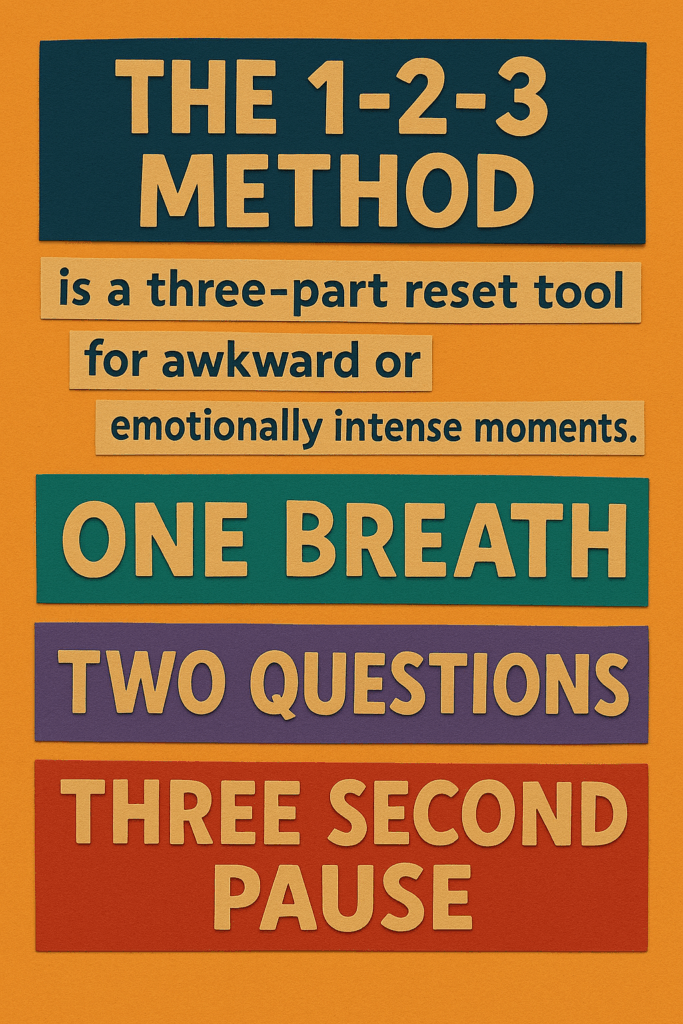The 1-2-3 Method is an amazing technique for those moments that are sometimes a little too human.
You forget someone’s name mid-handshake. You wave back at someone who wasn’t waving at you. You say “you too!” when the barista tells you to enjoy your drink.
And while most of these moments are harmless (and sometimes funny), other times, awkwardness can become paralyzing. You start to dread conversations. You second-guess your every word. You feel like you just don’t know how to “human” the way everyone else does.
I’ve been there more times than I’d like to admit. But a simple mental tool—called the 1-2-3 Method—that changed everything for me. It’s easy to remember, easy to use, and surprisingly effective when things start to feel weird, tense, or emotionally off-balance.
Whether you feel socially awkward, emotionally overwhelmed, or just want a way to better handle life’s trickier interactions, this method can help.
Let me walk you through it.
What Is the 1-2-3 Method?
The 1-2-3 Method is a three-part reset tool for awkward or emotionally intense moments. It goes like this:
- One Breath
- Two Questions
- Three-Second Pause

Let’s break each part down—and I’ll share how it helped me survive one of my most cringe-inducing moments.
[This is also a great technique to use with an overbearing boss.]
1. One Breath
Before you say anything or react, just take one deep, intentional breath.
It sounds too simple to matter, but it does. That single breath gives you a fraction of a second to switch from automatic (aka panic mode) to intentional.
Here’s why it works: When you feel awkward, your nervous system gets hijacked. You might feel a spike of adrenaline, a tight chest, or a rush of thoughts. One deep breath tells your body, Hey, we’re safe. Let’s slow down. It grounds you.
I once met someone I’d admired online for years—someone in my field who I genuinely looked up to. I was so excited that I blurted out, “I’ve been watching you forever!”
Yikes.
The look on his face was pure confusion. I could feel the heat rising to my ears.
I was about to double down with more word-vomit when I remembered: Just breathe.
That one breath saved me from spiraling. It slowed my heart rate and gave me a moment to remember I wasn’t in danger—I’d just made a weird comment. And weird comments are survivable.
2. Two Questions
Now that you’ve grounded yourself, silently ask yourself two quick questions:
What’s really happening here?
What do I want to get across?
These questions shift you from self-consciousness to self-awareness. Instead of focusing on how awkward you feel, you focus on what matters in this moment.
Let’s say you’re talking to someone and you feel like you’re rambling. Ask:
What’s really happening here? I’m nervous and talking a lot. That’s okay.
What do I want to get across? I want to seem interested and friendly, not desperate for approval.
Now you can gently guide the conversation—or yourself—back on track.
3. Three-Second Pause
This is the hardest part, but it’s the magic sauce.
Pause. Count to three. Let silence do its thing.
So many of us rush to fill every gap in conversation. We assume silence is a sign we’re boring or messing up. But in truth, a short pause gives you time to recalibrate—and gives others space to speak.
Three seconds of silence might feel like an eternity, but to everyone else, it’s barely noticeable. And it shows confidence.
I once went on a first date where the conversation just… stalled. We were sitting across from each other, and out of nowhere, everything went quiet. No phones, no waiter interruption—just an awkward silence that stretched a little too long.
I started to panic. My brain flooded with thoughts like “Say something! Anything!” But instead of blurting out a nervous monologue about my favorite cereals or why I alphabetize my bookshelf, I remembered: Take one breath. Ask what’s happening. Pause.
So I did.
What was really happening? Just two people who didn’t know each other very well, sharing a normal human moment of silence. What did I want to get across? That I was curious, calm, and genuinely enjoying getting to know him.
I smiled, waited a beat, and asked him a simple question about his favorite way to unwind after a long week. That opened up a whole new thread of conversation, and the tension dissolved. It didn’t turn into love, but it did turn into a relaxed, human connection.
That tiny pause gave me the power to reset—without spiraling.
Why the 1-2-3 Method Works
It’s not about being perfect. It’s about being present.
Social awkwardness often comes from either being too far in the past (“I can’t believe I said that”) or too far in the future (“They’re going to think I’m weird”). The 1-2-3 Method pulls you back to now.
Here’s what each part does on a deeper level:
- One Breath lowers your physiological arousal.
- Two Questions engage your prefrontal cortex—your rational, thinking brain.
- Three-Second Pause gives space for better outcomes, instead of impulsive reactions.
Together, they short-circuit the spiral of awkwardness.
Who Can Use This?
Anyone. Seriously.
- Socially anxious? Use it before walking into a room.
- In a tense conversation? Use it before you reply.
- Public speaking? Use it when you forget your next line.
- Customer service? Job interview? Family drama? Yes, yes, yes.
It’s not about faking confidence. It’s about creating room for your real self to show up—calm, clear, and connected.
Final Thoughts: You’re Not Broken—You’re Just Human
If you’ve ever walked away from a conversation replaying every word in your head, you’re not alone. If you’ve ever felt like you don’t know how to “do” small talk, or if you worry that you’re too much or not enough—this method is for you.
It’s not a fix-all. But it’s a start. And sometimes, that’s all we need.
So the next time you feel yourself slipping into the awkward abyss, try the 1-2-3 Method.
Breathe. Reflect. Pause.
And remember—you’re doing better than you think.

